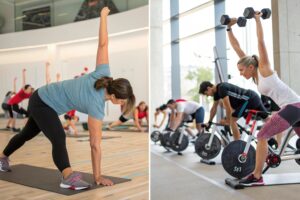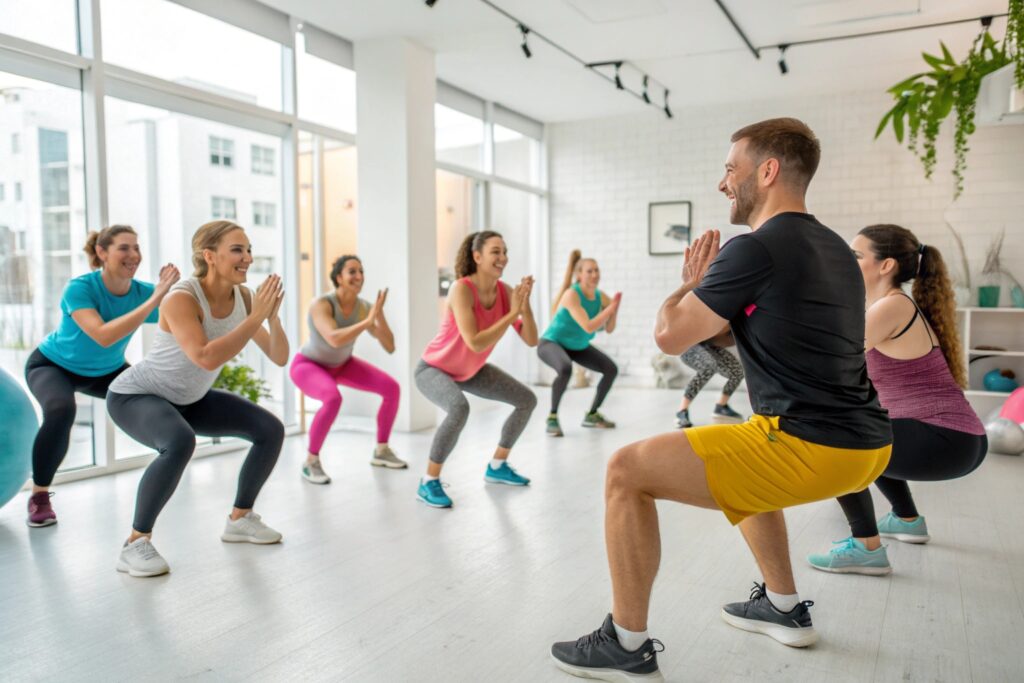Group fitness classes have surged in popularity because they blend energy, expertise, and community into a single, high‑impact workout. The Benefits of Group Fitness Classes: How Working Out with Others Can Boost Results are evident in every session, from higher motivation to improved technique. Whether you’re a beginner or a seasoned athlete, the social dynamics of a class can accelerate progress, keep you accountable, and make exercise feel less like a chore and more like a celebration.
Section 2: Enhanced Motivation and Accountability in Group Fitness

Why a Crowd Can Keep You Going
One of the most powerful drivers of consistency is the sense of accountability that comes with showing up alongside others. When you know a group expects you to be present, the internal resistance you might feel in a solo setting diminishes. The collective energy of participants cheering each other on creates a psychological push that encourages you to finish that last rep or sprint the final 50 meters, even when your muscles beg for rest.
Competitive Spirit Without the Pressure
Friendly competition is a natural byproduct of group classes. Unlike high‑stakes individual sports, the rivalry in a group setting is supportive and non‑punitive. Seeing a teammate hit a new personal best can inspire you to raise your own benchmarks. This subtle, shared ambition transforms ordinary workouts into performance‑boosting sessions, turning personal goals into team goals.
Section 3: Social Connection and Community Building
Creating Bonds Through Shared Sweat
Humans are inherently social creatures, and fitness environments provide a fertile ground for building relationships. The recurring rhythm of weekly classes fosters a sense of familiarity—participants learn each other’s names, celebrate milestones, and offer encouragement during tough moments. These bonds extend beyond the studio walls, often resulting in lasting friendships that motivate you to stay active even on off‑days.
Support Networks for Healthier Lifestyles
Beyond the camaraderie, group fitness creates informal support networks that can improve nutrition, sleep, and stress management. Members frequently exchange healthy recipes, recovery tips, and personal success stories. This exchange of knowledge amplifies the benefits of the workout itself, as you adopt a holistic approach to wellness guided by real‑life experiences from people who understand your journey.
Belonging Improves Mental Health
Feeling part of a community reduces feelings of isolation and can lower symptoms of anxiety and depression. The endorphin surge from exercise combined with the emotional uplift of belonging triggers a positive feedback loop—boosted mood leads to higher attendance, which in turn reinforces the emotional benefits. Over time, this social reinforcement becomes a cornerstone of mental resilience.
Section 4: Improved Technique and Safety Through Expert Guidance

Trained Instructors Provide Real‑Time Corrections
Professional instructors monitor form, posture, and movement patterns throughout the class. Their immediate feedback helps you correct common errors—such as rounded backs during deadlifts or knee valgus in squats—before they become ingrained habits. Proper technique not only maximizes the effectiveness of each exercise but also dramatically reduces the risk of injury.
Progressive Programming Tailored to Group Levels
Group classes are designed with progressive overload in mind. Instructors often incorporate variations and scaling options (e.g., using lighter dumbbells, resistance bands, or modified movements) so that participants of varying fitness levels can safely challenge themselves. This structured progression ensures that you’re consistently moving toward higher performance without overreaching.
Educational Moments Enhance Long‑Term Skill Retention
Many classes intersperse brief teaching segments—explaining the biomechanics of a movement, the purpose of a particular drill, or the science behind heart‑rate zones. These educational nuggets empower you to transfer knowledge to solo workouts, fostering a deeper understanding of your body’s mechanics and cultivating lifelong fitness competence.
Section 5: Variety, Structure, and Goal‑Driven Workouts

Diverse Formats Keep Plateaus at Bay
From high‑intensity interval training (HIIT) and spin to yoga, Pilates, and boot‑camp circuits, group classes offer a rotating menu of modalities. This variety prevents the monotony that often leads to plateaus. Switching between aerobic, strength, and mobility sessions forces your body to adapt continuously, encouraging steady gains in endurance, power, and flexibility.
Built‑In Periodization for Optimal Results
Well‑crafted class schedules follow periodization principles—cycles of loading, deloading, and peaking—mirroring the programming used by elite athletes. Instructors plan weeks focused on endurance, followed by strength weeks and recovery weeks. This systematic approach optimizes physiological adaptations while minimizing burnout.
Goal‑Centric Sessions Align With Personal Objectives
Many studios organize themed series (e.g., “12‑Week Marathon Prep” or “Core Strength Challenge”) that align directly with common fitness aspirations. By joining a goal‑oriented class, you gain a clear roadmap and a supportive peer group that shares the same end‑point, making it easier to track progress and celebrate milestones together.
Section 6: Long‑Term Health Benefits and Lifestyle Integration
Consistent Participation Reduces Chronic Disease Risk
Regular attendance at group fitness classes correlates with lowered blood pressure, improved cholesterol profiles, and better insulin sensitivity. The combined cardio‑vascular and resistance components found in most classes address multiple risk factors simultaneously, offering a comprehensive preventive health strategy without the need for separate specialized programs.
Behavioral Conditioning for Sustainable Habits
The routine of a scheduled class embeds exercise into your weekly rhythm, turning it from an optional activity into an ingrained habit. Over time, the mental cue associated with class times triggers automatic preparation—laying out workout gear, planning meals, and prioritizing sleep—creating a virtuous cycle that sustains long‑term health.
Enhanced Quality of Life and Longevity
Beyond measurable health metrics, group fitness enriches daily life. Participants report higher energy levels, better mood regulation, and increased confidence in physical abilities. These intangible benefits translate into improved performance in everyday tasks—from lifting groceries to playing with children—contributing to a higher overall quality of life and a greater chance of living a longer, more active life.
Embracing the benefits of group fitness classes is more than a trend; it’s a scientifically backed pathway to better physical performance, mental resilience, and social fulfillment. By leveraging motivation, expert guidance, community support, and structured programming, you can unlock results that are difficult to achieve on your own. Ready to experience the boost? Find a local class that fits your goals, show up consistently, and watch how working out with others transforms both your body and your life.



